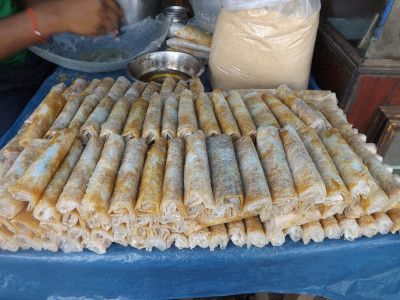Feasting on Pootharekulu to lifelong friendship

My earliest memories go back to living in a small village, Khajipalem in a large farm house when I was 4 years of age. Khajipalem is about 18 Kilometers from Bapatla where my నానమ్మా (Nanamma is paternal grandmother in Telugu) used to live. Khajipalem is still a small village with a population of 6440 as of this writing.
నాన్న (Nanna is father Telugu) rented the house from a farmer. It was a typical Andhra Pradesh farmhouse with the house located squarely in the middle of a large piece of land surrounded by a boundary wall. Four large verandas without a roof encircled the main living quarters as though the house was built in the middle of four rectangular blocks of concrete slabs. Verandas are utilitarian and practical for drying grain and most farmhouses have at least a couple of them. They are great for running around, riding bikes and other far more important fun things than boring and mundane tasks like drying grains. At least that was what I cared about during the time I lived there.
The house itself was small. There was a large covered veranda in the front and a large rectangular room that spanned the entire length of the living quarters with a second large room of equal size right next to it. The second room was divided into two square rooms. The main entrance from the front veranda led to the first square room from which you can enter the large room to the left and the kitchen right behind it. The large room had a second door connecting it to the kitchen and another one on its left that opened onto the side veranda. The first square room in the front doubled as Amma’s sewing room, family room, and a spare bedroom for our occasional overnight guests. The kitchen was small with a large bamboo screen as its back wall with a small opening that opened onto the back veranda.
All four of us slept in the large room on the left. I remember sleeping under the mosquito netting. Mosquitoes were constant companions for people living in a rice growing village surrounded by rice fields. Rice fields are usually flooded with water and are ideal mosquito breeding grounds. They are also home for snakes. Farmers tap their walking sticks on the ground as they walk along the rice fields to announce their arrival to snakes. Snakes have a type of internal ear with a few bones in their jaws that can sense slight vibrations on the ground. When snakes sense the vibrations produced by tapping a stick on the ground, they know to lay low to stay away from humans. It is ironic that poisonous snakes lurk in those peacefully serene and green rice fields that yield the grain that sustains humans, birds, and animals. As soon as the Sun sets, mosquitoes come buzzing in. We ate dinner early and took refuge under the mosquito nets to escape the blood sucking tiny vampires and listened to bedtime stories. Nanna read stories and Amma recited Telugu poems. We would recite ఆంజనేయ దండకం (Anjaneya dandakam) to call upon the mighty Anjaneya to ward off Bhoota, pisacha (ghosts and goblins) and keep us safe during the night. Too bad the mighty Anjaneya couldn’t save us from mosquitoes.
There was no running water. I don’t recall if there was a well in the yard. Water was brought from a కాలవ (kalava is canal in Telugu) or village communal well for drinking, cooking, bathing, washing clothes, and dishes in large ఇత్తడి బిందెలు (Ittadi bindelu are brass pots in Telugu) by a servant. There was a small red brick structure with four walls and a small opening in one corner that served as a bathroom on the back veranda. This bathroom was added right before we moved in to accommodate our needs. Most villagers took baths right next to their wells in their yard. They would draw water from the well and wash themselves. They wore some form of clothing for modesty while they bathed. The bathroom didn’t have a roof and there was no door. I remember watching the steam rise as Nanna took a bath with hot water in the mornings. Water was heated on a stove in a pot and the boiling hot water was mixed with cold water in a bucket. Bathing involved taking water from the metal bucket with a ఇత్తడి చెంబు (Ittadi chembu is small brass pot in Telugu) and pouring over head and body.
The land the house sat on was very large and the yard was full of trees and shrubs. A squat style septic tank latrine was in the far right corner of the backyard. It was a trek to get there on my small legs. It felt like a mile away. I was scared of walking there by myself when we first moved into that house. As years went by I started walking to the latrine in the backyard by myself.
I used to run around the yard in hawaii sandals, carrying a cute little yellow plastic basket collecting కుంకుడు కాయలు (Soapnuts) and other fruits that fell to the ground. Our landlord was irritated that I was collecting them. As my range grew, his complaints got louder and louder. He wasn’t happy that I was stealing fruits from the yard. He would complain to Nanna about me taking his కుంకుడు కాయలు (Kunkudu kayalu) and that gathering fruits was not allowed according to the rental contract. Nanna would try to reason with him by showing how small my yellow basket was and how very few కుంకుడు కాయలు (Kunkudu kayalu) could fit in there.
I vaguely remember our landlord dressed traditionally in a ధోవతి (dhovati or dhoti). ధోవతి (dhovati or dhoti is a type of sarong worn traditionally in India. He had a stern face without a smile, especially when he was complaining about me. It was difficult to find houses for rent in a village to begin with and it would be very unwise to make your landlord unhappy over a few kకుంకుడు కాయలు (Kunkudu kayalu). Nanna compensated him for the fruits. Nanna was a compassionate and gentle soul. He didn't scold me or ask me to stop my foraging expeditions. I don't know if there were any snakes in the yard. If there were any, I didn't have any unfortunate encounters with them.
There was a తాటి చెట్టు (Palm Tree) and a కొబ్బరి చెట్టు (Coconut tree) at the front left corner of the property very close to the boundary wall. I could see the Palm tree as I stood on the front veranda and the veranda on the left side of the house. I have a very vivid memory of one night standing on the front veranda watching the stars holding Nanna’s hand. It was a very windy పూర్ణిమ (Purnima is full moon night in Telugu). I could see the trees in the yard swaying in the wind.
I asked Nanna, “Why are the leaves and branches on trees moving?”
Nanna answered, “They are moving because wind makes them move .”
Then I asked, “Where does the wind come from?”
Nanna promptly replied, “Trees make wind.”
I am not sure if Nanna didn't want to explain the air bubble around the earth, earth rotating on its own axis, and around the Sun to a four year old or if he wasn’t good at explaining complex working of the milky way in a way a four year old could understand. I find myself struggling to explain concepts at times. Maybe I inherited that trait from Nanna. My husband is good at explaining phenomena and my boys are spared from my “wind comes from trees and wind makes trees move” kind of explanations.
I remember bringing injured birds inside and nursing them back to health. We fed rice grains to them. Some birds got better and flew away and some didn’t survive. We were excited when a bird we nursed back to health took flight and cried when another didn’t survive. The house was very hot during the summers. Amma soaked ఖర్జురాలు (Kharjuralu are dates in Telugu) in water for us to drink. Date water is good for the body as it cools it down. At night, the trees cast shadows and one could imagine and see all sorts of scary creatures.
Our neighbors across the street became good friends with our family. A dirt road separated the two houses and there was no traffic other than people, animals and occasional bullock carts. Our neighbor Rajugaru and his wife, Venkayamma were very kind and friendly people. Unlike our landlord, Rajugaru had a smile on his face as he greeted us whenever he saw us. I remember his kind face and friendly smile.
Rajugaru wore తెల్ల లుంగీ (white Lungi) and తెల్ల లాల్చి (Lalchi is a long shirt in Telugu) and కండువా (kanduva is a Scarf in Telugu). He walked barefoot the majority of the time and wore leather chappals made by a local cobbler when he was out and about the village. His wife, Venkayamma wore colorful cotton woven sarees. They had one daughter who was like a big sister to me. She hung out with me after she came from school when she didn't have any chores. Everybody in their family had lots of chores such as milking cows, feeding animals, washing them and many others. Their house was a small hut with mud floors and it sat on a large yard full of cows and buffaloes, and chickens. They grew vegetables in their yard for their family.
Rajugaru and his wife made delicious Pootharekulu, a dessert made out of wafer-thin rice starch layer resembling paper made out of very thin rice batter on a super hot కుండ (kunda is clay pot in Telugu). Clay pot is prepared for use by smoothing the surface for three days, and the pot is heated and wiped with a cloth dipped in oil. Pootharekulu are made on wood fired or తాటాకు మంట (thataku mata is Palm leaf fire in Telugu). Once the fire is made, the clay pot is placed bottom up on the top of the fire covering the fire as it heats the pot up from inside. Cloth dipped in the batter is quickly dragged over the hot clay pot and a thin sheet of rice forms. These sheets are then stacked and cooled. Once they cool, నెయ్యి (Ghee) and బెల్లం (Jaggery) or sugar mixture are applied to a sheet and a second sheet is placed on top. Once two or three of these delicate sheets are stacked on top of each other applying నెయ్యి (Ghee) and బెల్లం (Jaggery) or sugar mixture to each of them, they are rolled together and cut into 4 inch by 2 inch rectangles of deliciousness. They just melt in your mouth. Just thinking about them is making my mouth water.
Pootharekulu were created in Atreyapuram, a village and mandal headquarters in the East Godavari district of Andhra Pradesh. Pootharekulu means coated sheets in Telugu. Pootha means coating and rekulu means sheets in Telugu. This sweet from Andhra Pradesh has a history of two to three centuries. These clay pots are passed down generation to generation like gold and silver.

I don’t remember the day we left Khajipalem. I was about 6 or 7 years of age when we moved from Khajipalem leaving Rajugaru and his family behind. Nanna and Amma remained friends with Rajugaru and his wife for a very long time. They invited each other to weddings to celebrate with and funerals to mourn with. A friend of mine aptly draws a parallel between Pootharekulu and good friendship. Just like Pootharekulu, friendship has layers and it gets sweeter and sweeter as the friendship matures. My parent’s friendship with Rajugaru and his wife Venkayamma started with sharing Pootharekulu and family dinners and lasted a lifetime.
